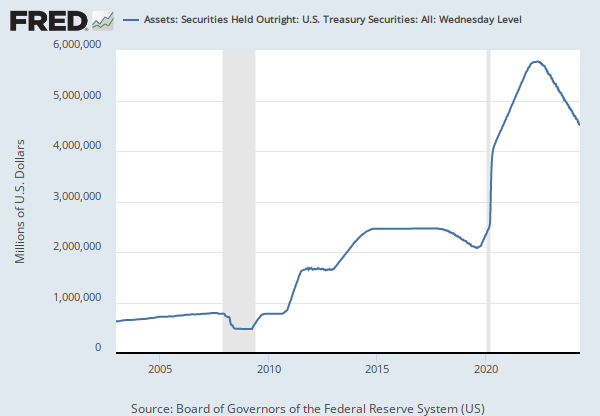Observations
2025-03-26: 0 |
Millions of U.S. Dollars, Not Seasonally Adjusted |
Weekly,
As of Wednesday
Updated: Mar 27, 2025 3:38 PM CDT
Observations
| 2025-03-26: | 0 | |
| 2025-03-19: | 0 | |
| 2025-03-12: | 0 | |
| 2025-03-05: | 0 | |
| 2025-02-26: | 0 |
Units:
Frequency:
Write a custom formula to transform one or more series or combine two or more series.
You can begin by adding a series to combine with your existing series.
Now create a custom formula to combine or transform the series.
Need help?
For example, invert an exchange rate by using formula 1/a, where “a” refers to the first FRED data series added to this line. Or calculate the spread between 2 interest rates, a and b, by using the formula a - b.
Use the assigned data series variables (a, b, c, etc.) together with operators (+, -, *, /, ^, etc.), parentheses and constants (1, 1.5, 2, etc.) to create your own formula (e.g., 1/a, a-b, (a+b)/2, (a/(a+b+c))*100). As noted above, you may add other data series to this line before entering a formula.
Finally, you can change the units of your new series.
Add the minimum, maximum, and average calculations of selected bars to the graph
Write a custom formula to transform one or more series or combine two or more series.
You can begin by adding a series to combine with your existing series.
Now create a custom formula to combine or transform the series.
Need help?
For example, invert an exchange rate by using formula 1/a, where “a” refers to the first FRED data series added to this line. Or calculate the spread between 2 interest rates, a and b, by using the formula a - b.
Use the assigned data series variables (a, b, c, etc.) together with operators (+, -, *, /, ^, etc.), parentheses and constants (1, 1.5, 2, etc.) to create your own formula (e.g., 1/a, a-b, (a+b)/2, (a/(a+b+c))*100). As noted above, you may add other data series to this line before entering a formula.
Finally, you can change the units of your new series.
Add the minimum, maximum, and average calculations of selected bars to the graph
Data in this graph are copyrighted. Please review the copyright information in the series notes before sharing.
Notes
| Title | Release Dates | |
|
|
||
| Central Bank Liquidity Swaps held by the Federal Reserve: Maturing in over 10 years | 2010-02-04 | 2010-02-17 |
| Central Bank Liquidity Swaps held by the Federal Reserve: Maturing in over 10 years (DISCONTINUED) | 2010-02-18 | 2010-05-12 |
| Central Bank Liquidity Swaps held by the Federal Reserve: Maturing in over 10 years | 2010-05-13 | 2019-08-20 |
| Assets: Central Bank Liquidity Swaps: Central Bank Liquidity Swaps: Maturing in over 10 Years: Wednesday Level | 2019-08-21 | 2025-03-27 |
| Source | ||
|
|
||
| Board of Governors of the Federal Reserve System (US) | 2010-02-04 | 2025-03-27 |
| Release | ||
|
|
||
| H.4.1 Factors Affecting Reserve Balances | 2010-02-04 | 2025-03-27 |
| Units | ||
|
|
||
| Millions of Dollars | 2010-02-04 | 2019-08-20 |
| Millions of U.S. Dollars | 2019-08-21 | 2025-03-27 |
| Frequency | ||
|
|
||
| Weekly, As of Wednesday | 2010-02-04 | 2025-03-27 |
| Seasonal Adjustment | ||
|
|
||
| Not Seasonally Adjusted | 2010-02-04 | 2025-03-27 |
| Notes | ||
|
|
||
|
The FOMC has authorized temporary reciprocal currency arrangements (central bank liquidity swaps) with certain foreign central banks to help provide liquidity in U.S. dollars to overseas markets. These swaps involve two transactions. First, when the foreign central bank draws on the swap line, it sells a specified amount of its currency to the Federal Reserve in exchange for dollars at the prevailing market exchange rate. The foreign currency that the Federal Reserve acquires is placed in an account for the Federal Reserve at the foreign central bank. This line in the statistical release reports the dollar value of the foreign currency held under these swaps. Second, the dollars that the Federal Reserve provides are deposited in an account for the foreign central bank at the Federal Reserve Bank of New York. At the same time as the draw on the swap line, the Federal Reserve and the foreign central bank enter into a binding agreement for a second transaction in which the foreign central bank is obligated to repurchase the foreign currency at a specified future date at the same exchange rate. At the conclusion of the second transaction, the foreign central bank pays a market-based rate of interest to the Federal Reserve. Central bank liquidity swaps are of various maturities, ranging from overnight to three months. |
2010-05-13 | 2025-03-27 |
Release Tables
Permalink/Embed
modal open, choose link customization options
Select automatic updates to the data or a static time frame. All data are subject to revision.









